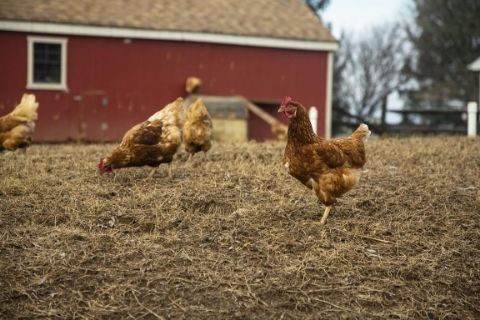
There are different methods you can take to have your own chicken coop, but if you’ve decided on building yours from the ground up, there are some extra steps you’ll need to take. Building a chicken coop can be the most affordable option and can offer the greatest customizability, but you’ll want to do it right the first time. Any mistakes can endanger your feathery, egg-laying gals, so before you get at it, we have some tips for how to build a chicken coop for you to read up on.
Pick a Safe Plot of Land
The very first thing to think about before you consider a chicken coop is the location. When building a coop, remember that you aren’t just finding space for the home itself—you’re finding space for the chickens’ yard, also known as a “chicken run.” If you’re building in an urban setting, the chicken run will be entirely enclosed in chicken wire. Estimate about ten square feet per chicken in the coop for their outdoor space. However, if you live in a rural area, you might consider making a larger chicken run for your chickens to pasture.
With either decision, make sure to get the dirt tested before you build. Some hazards can poison your chickens through the dirt outside, such as lead pollution. Chickens peck at the ground often, making the soil in the chicken run an essential part of their lives. If a chicken gets sick, they can pass it on through their products and onto your family.
Design Your Blueprint
You’re going to want a design for your chicken coop before you begin building it. Even if it’s simple, a blueprint is necessary for any construction project. Map out the dimensions of each part along with any special additions you might want. Remember that proper chicken coops need lots of ventilation and airflow! Add windows towards the mid-height of the coop and gaps or holes to the highest areas on the side of the coop. Keep the bottom of the enclosure free of ventilation to keep your chickens warm during cold weather and to keep slithering predators and pests out from the bottom.
Ensure approximately four square feet of space per chicken with lots of room for them to perch and roost. Add any extra flair to your coop, like automatic egg collection, onto the blueprint as well. Get creative!
Follow City Guidelines
You’ll likely need a permit to build your coop before you start construction—especially in a populated town or city. Even though it’s your yard and you own it, the city still has to approve many different construction projects before they begin. Provide the blueprint and any other required materials based on city regulations.
The city may have more rules on owning chickens besides just the construction of coops, so be sure to read any materials given by the city government thoroughly.
Acquire Materials
Once your permit is received, start collecting the physical materials you’ll need for the chicken coop.
Wood
You can reuse a multitude of materials for chicken coops, but most chicken coops are made of wood. If you recycle wood, make sure that it’s safe for chickens to live in. Wood treated with chemicals can be extremely dangerous for your chickens.
Fasteners and Tools
Know beforehand how many screws, nails, or hinges you’ll need for construction. Having extra materials doesn’t hurt if you can afford them. Mistakes can happen at any time during construction—luckily, having extra materials can save you from having to stop for a trip to the store. Make a list of any tools you’ll need. If you don’t plan on doing any more construction after the chicken coop, see if you can borrow some tools from friends before putting money into buying some.
Chicken Wire or Hardware Cloth
Stock up on chicken wire or hardware cloth. You’ll need a lot of the stuff, and even beyond then, you’ll need more on hand for repairs and maintenance once the coop is established. Hardware cloth is better for chicken coops, as it can keep predators out due to its stronger nature. Chicken wire is flimsier, meaning it can harm your birds if broken.
Paint
Lastly, purchase the chicken-safe paint or stain you want for the outside of the coop. Get a couple of different paintbrushes and a roller along with the paint to make the job easier.
Don’t Forget the Safety Equipment
Safety is a priority when working on any construction project. Invest in safety goggles, gloves, and facemasks. When woodworking, sawdust will get everywhere. Don’t wear any clothes you care about keeping in pristine condition. If you have sensitive ears and are working with power saws or tools, buy a package of earplugs to save your hearing.
If you need a ladder for any part of the project, make sure you have one around and practice proper ladder safety.
Get to Building!
With everything in place, it’s time to build! Enlist some friends or family members to help you; then, get to work. Check the weather beforehand and make sure that wherever you’re building is sheltered from the elements in case of sudden storms. Follow a guide if you need to and take as much time as necessary. Take breaks often, especially in high heat. Construction is at your pace—no one else’s.
For any large ventilation gaps or holes, install a layer of hardware cloth to avoid predators coming in or chickens getting out.
Before you start painting the finished coop, look to make sure that the weather continues to be favorable.
Finish With a Safe Chicken Run
Once the coop itself is finished, start fencing off an area for the chickens to have outside time. Install the chicken ramp and anchor wood posts for your hardware cloth to attach into. Chicken wire should be reserved for quick, temporary fixes or to be buried beneath the main fencing to deter predators from digging. Chicken wire’s primary use is for keeping chickens out or separated; it doesn’t work well against other animals. Don’t forget to install a door to the run that you can enter from!
Furnish and Fill the Coop
Now that you have a finished chicken coop, it’s time to fill it with bedding, feed, and chickens. The best hay that you can choose for chicken bedding can be used as fertilizer for your garden and will reduce the stink of waste. Lucerne Farms’ Koop Clean™ Chicken Bedding is not only excellent for fertilizer, but it can also be used immediately after cleanup. Other types of hay for chickens often require you to wait before throwing dirty bedding in the garden. Its uncanny ability to eliminate the ammonia stink of chicken waste makes it perfect for suburban and urban backyard chicken coops.
Always consider what kinds of chickens you’ll have in your coop before making final decisions. Different chickens require different approaches, but when it comes down to how to build a chicken coop, the advice will always remain the same. Once you construct your first coop, the fantasy coop of your dreams becomes even more realistic!





